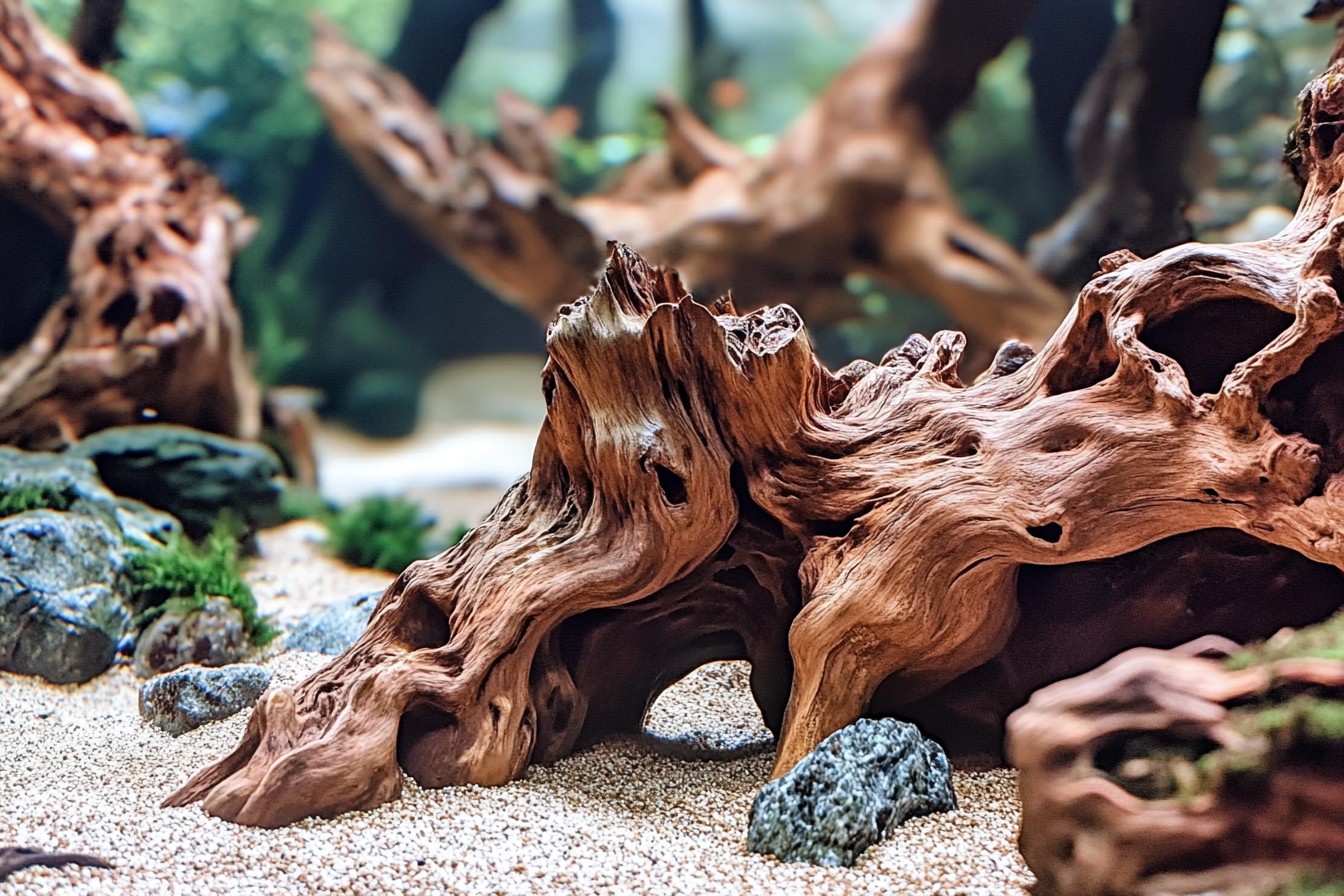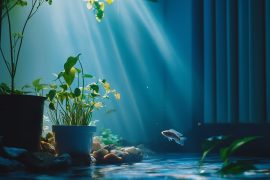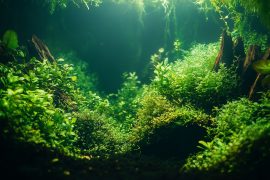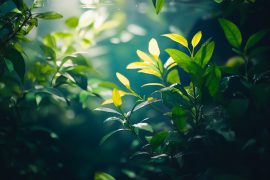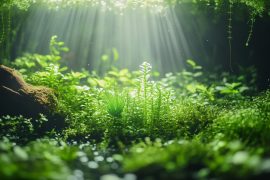My garage resembles a murder scene… for rocks. The blue tarp on the floor is the specific color of cobalt, chunks of stone lay everywhere, and tools imaginable in a horror film lie in sight: chisels, hammers, and a strange serrated knife that I was foolish enough to purchase from a stranger during a gem show. Tom, my neighbor, came by yesterday to pick my pressure washer, and before even stepping into the garage, he dazedly stood at the entrance for half a minute, wide eyed, before awkwardly asking if everything was… okay. He was polite enough to pretend this wasn’t the awkward turn of events it clearly was. To which I had to clarify, no, I wasn’t plotting anything evil, just deconstructing some seiryu stone for a new tank build and explaining my thought process. In response, he nodded lightly and gently retreated. Not much I can blame him for.
I have been so fixated on hardscape materials that it is becoming a problem. If I’m being honest with myself, it is quite concerning. Just last month, I traveled a whopping one hundred seventy-eight miles, each direction, just for a central Florida quarry. A forum user posted some limestone formations that had the perfect weathered texture and my suspension, for some reason, took damage from that trip. The quarry owner thought I was out of my mind because I was rejecting perfect specimens that were too symmetrical or had the wrong visual weight. Eventually, the owner just told me to grab whatever I wanted.
That ah-ha moment that I wish I had known before starting is that wood and rocks in aquascaping aren’t mere decorations. They are the skeleton of your entire layout. Combine all of the vibrant marine life that range from plants to advanced fish from the best aquarist to you name it, but without a sturdy hardscape, it will look off. And without a doubt, using the metaphor “putting lipstick on a pig, or should I say a wet pig with fins,” is wildly accurate because logically, you will accomplish nothing but a weak and soft foundation that will always feel off, like a room with oversized furniture.
When I designed this beautiful high-tech 60-gallon aquarium for a restaurant in Miami Beach about eight years ago, I learned a lesson the hard way. My client wanted it in Iwagumi style—a bare minimum Japanese approach with rocks and carpet plants, right? Easy, right? Not quite. I spent weeks finding these specific pieces of ohko stone and arranging them in the golden ratio in my workshop. The installation went smoothly. I added the aquasoil, planted the HC Cuba carpet, installed the CO2, the works.
Then I received a call, six weeks in. “Everything’s growing great, but… it looks boring.”
Shocking, I know. I was heartbroken. I drove down there ready to defend my artistic vision, but the moment I walked in, I took one glance and… there it was. Boring. Yes, the rocks were technically perfect—right sizes and placement— but they had no story, no character, no life. No emotion whatsoever. Just rocks. Yes, pretty rocks, but useless. I realized that in my attempt to follow the textbook, I lost sight of the emotional piece. That tank made me realize hardscape is not only physical, but emotionally architectural as well.
I’ve begun to detach myself from how wood and rocks make me feel on paper and start focusing on how they truly make me feel. Part of a piece of spiderwood is lying in my 40-gallon aquarium which I picked up during camping near Ocala National Forest. Technically, it’s far from perfect—one side is a bit flat where it was pressed against a riverbank, and there’s this weird knot that throws off the branching pattern. As I examine it, I relive the incredible memories from that weekend. The oaky scent of the fire, my friend Ellie losing her calm thinking she saw a water moccasin which turned out to be nothing but a stick and the light peeking through the cypress trees during morning. No store-bought perfect piece will ever have the story that this wood encapsulates.
This is not to say that I oppose materialistic stores! Marcus, my UPS guy, seriously must think I’m a complete rock hoarder given how often his back gives out from delivering boxes from specialty suppliers. “More rocks?” inquires Marcus with a mixture of pity and judgment. “Different rocks,” I respond. Unfortunately, he lacks the context of the massive difference between seiryu stone and ryuoh stone like I have tried to explain to him countless times.
No one seems to relate temperature and hardscape in the same sentence. Not water’s temperature—the visual temperature. All stones and woods generate feelings that are either warm or cool. Dragon stone definitely adds warmth with its reddish-orange tones while gray seiryu works to cool things down. I put both of these in the same tank once thinking I was clever and playing with contrast. Instead I ended up with a visual tug-of-war that was as unsettling as two strangers forced to share a single seat on a long bus ride. In the end, I had to demolish it and start from scratch.
As far as I know, the most underrated hardscape material is plain old river rocks. The polished ones from craft stores? No, because they look like hell under water. I’m talking about the grungy ones found in any stream, pitted and dull colored. River rocks aren’t extreme but there’s something extremely honest about them. I have a bucket full of them collected from various trips. Each piece has its own story: that smooth flat one from when I went fly fishing with my dad in the Smokies and the speckled oval from the stream behind my ex’s parents’ house (strangely enough, I lost the girlfriend but kept the rock).
Wood can be a lot more difficult to work with than stone, precisely because it is less predictable. With stones, it’s straightforward. Wood, on the other hand, has some secrets. It has hidden pockets of air that, months later, might decide to release; doing so will send your meticulous aquascape substratum into a tailspin like an underwater eruption. Supposedly stable rot patches that appear stable but slowly begin to evaporate, causing branches to shift. And por supuesto, let’s not even talk about tannins. The first time I placed this gigantic piece of drift wood from Malaysia in a discus tank without properly curing the wood, I knew I was in trouble. The water looked like over steeped tea. It was an absolute panic. Oh, and the fishes all seemed to be dying in this brown water. Emergency water change, anyone?
I think many of us feel emotional connection with wood that is absent with stone. For example, I have an old mopani root in my storage room that I have used in more than six different aquascapes over the years. It isn’t anything remarkable, just a characterful piece that is solid with good branching. Whenever I consider using something else, I somehow land back at this piece. It is like bumping into an old friend that says, “Oh hey, it is you again. Let’s make another tank together.” I understand how forming an emotional bond with a piece of wood is absurd, but it isn’t when you are deep into this hobby.
A new level of magic is provided when hardscapes meet with plants. Watching the tendrils of java moss reach out to the rock face, or anubias roots climbing down the driftwood makes you contemplate life. I can spend hours thinking about these interactions without needing to fill the tank with water. Which plants go well with harsh rocks? Bolt gie stems would be perfect for these. Its like arranging a marriage where both parties need to get along because they will be together for years.
Ironically, the one thing aquascapers for detailed level perfection is the fact that no not one aquascaper compliments the sculpted rocks or the beautifully placed pieces of sculpted driftwood. The best compliment any aquascaper could receive is if a customer looks at a finished tank and does not give a single thought to the hardsculptane and instead feels a sense of curiosity, calm or wonder. In simpler words, without hardscultps being crafted or adjusted inappropriately, swimming tourists will use the left over space feeling the benefits of nature in disguise.
In the following days, I am going to visit a construction site of a new office building that is currently being excavated. One of my foreman clients texted me saying that they “found some weird rocks” that came to mind. Am I spending my Saturday trying to uncover aquascaping materials in the layers of mud at a construction site? Yes. Am I going to look crazy while doing so? Of course. But in the end, I can’t let society determine what this hobby I am passionate about.
